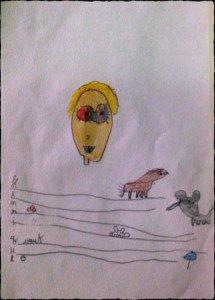Children's Creativity using Poetry
Malu Sciamarelli, Brazil
Malu Sciamarelli has been working in Brazil for over 20 years as an English teacher, teacher trainer, and materials designer. Currently, her main interests are writing and using her own short stories and literature in her Creative Writing classes. E-mail: malusciamarelli@gmail.com, website: www.malusciamarelli.weebly.com

Menu
Introduction
Mr. Spider, by Alan Maley
Acrostic poems
Poetry walk
Conclusion
Children are inherently creative. However, as they grow up, they lose their willingness to try new things due to a series of factors, being among them: fear of failure, opinions of others become important, they want to know the 'right answer'.
At the same time, teachers make use of the so-called 'creativity killers' in the classrooms, such as:
- rewards: they inhibit children's exploration and imagination;
- shadowing: observing closely and managing children's projects is detrimental to their creativity;
- limited choice: giving children only the 'right answer' and not allowing alternative solutions kill their creativity;
- over-scheduling: a full diary does not allocate time for day-dreaming, when we get the best ideas.
Instead of stifling children's creativity, teachers should nourish and develop them. Here are some suggestions that can promote creativity in the language class:
- provide regular opportunities for hands-on experimentation, problem solving, discussion and collaborative work;
- actively encourage students to question, make connections, envisage what might be possible and explore ideas;
- use failure or setbacks as opportunities to learn;
- facilitate open discussion of the problems students may be facing and how they can solve them;
- ask open-ended questions;
- ensure that assessment procedures reflect creativity and innovation.
Another way of enhancing children's creativity is help them write a poem. Children may recognise the power of poetry - its ability to inspire emotions, and the pleasure and fun they can get from memorising a poem, or reading it again and again - but they may not know where and how to start writing their own poems.
There are also other things you can explore rather than only enhancing their creativity in the foreign language class. You can help them recognise the elements of a poem and explore different ways of writing one, and by doing so, you will enable children to:
- become familiar with the meaning of words and sentences;
- understand sentence structure;
- see how words rhyme;
- learn new vocabulary.
Also, in writing poetry, children will discover a new world of expression that is just as fun to share with others as it is to write.
I will now share three activities of writing poems with children and some examples.\
a. Choose a poem and read it aloud for the children. I chose 'Mr.Spider' by Alan Maley, and showed them a video in which Alan Maley himself reads it aloud.
Video: https://youtu.be/m2Yr_jwCPhE
The poem:
Mr Spider
'Please, Mr Spider, climbing up the wall,
Please don’t, please don’t, please, don’t fall!'
'Why are you so frightened?
Why are you afraid?'
'Because I think you’ll poison
The soup I’ve just made.'
'Oh Mr Spider, walking on the ceiling,
You give my tummy such a funny feeling.'
'What makes you so frightened?
What makes you afraid?'
'Because I think you’ll drop on me
And bite me till I’m dead!'
'Please, little children, sitting down below,
Please don’t run away. Please don’t go.
You really mustn’t think that I
Am poisonous or mean.
Remember that I eat the flies
And keep your houses clean.'
(Alan Maley)
b. Talk about where each line of the poem ends and how it creates rhyme, affects the meaning of the poem, and might even make the poem look a particular way.
c. Read it again as a group.
d. Select some words that rhyme. In this case, I selected: wall / fall; afraid / made; mean / clean; below / go.
e. Help them write another poem individually, in pairs, or as a group using the words selected and about the same topic.
Example:
Seeing the spider climbing up the wall,
My first thought was, 'it will fall!'
I was also so afraid
When I saw the web it's just made!
Then I shouted, 'spiders are so mean!'
But then I saw how the room was clean.
I sat with all the children down below
And said, 'little spider, please, don't go!'
f. As a follow-up activity, you can ask them to read it aloud, and draw a picture of a spider.
a. Show the children how to write an acrostic poem with their names, in which the first letter of each line spells out his or her name, when read top to bottom.
b. Once the children write a poem based on his or her own name, they can write about family members, friends, or pets.
c. If the children are too young, you can ask them to draw rather than write, and read it aloud.
d. These are some examples of a group of six-year-old children:
(Children’s creativity – image 1

(Children’s creativity – image 2

And this is what they said about their poems:
Kangaroos live in Australia
Alligators like dirty rivers
Insects are everywhere and
Octopuses live in the sea.
Horses are strong and
Elephants too. My
Nose moves like
Rabbits noses when
Insects bite it.
Quack, a duck said when it saw an
Umbrella protecting an
Egg from the rain!
The possibilities for learning a foreign language through movement are inexhaustible. Consider acting out the meaning of individual words from stories and poems. Through movement, children can begin to comprehend the meaning of action words such as pull, push, jump, leap, hop or descriptive words such as kind, lovely, polite, bitter, sugary.
However, movement activities that require children merely to imitate the teacher do not foster creativity. But movement activities with emphasis on problem-solving, discovery, and self-expression can make a substantial contribution.
Creative movement activities also foster imagination. One of these activities is the 'poetry walk'. And here is how to do it:
a. Go on a 'school poetry walk'. Stop at various points - the reception, the library, the park, the garden, the kitchen, etc.
b. Ask the children to write a sentence or two that describes not only what they see, but touch, smell, hear, and taste, if possible.
c. Go back to the classroom, and ask the children to put their sentences together.
d. Ask them to revise and shorten those sentences and turn them into a poem.
These are some examples:
The colours of the garden
reflect the rainbow
that crosses the sky.
Ants, bees and butterflies
Are so small and so different,
but they are all happy at sunrise.
What a delicious smell!
What are you baking?
'Chocolate cake', we yelled!
So many books, so many words
If we read them all
Will we become nerds?
Remember that creativity flourishes when things are done for enjoyment. What matters is the pleasure, not the perfection. Give the children opportunity to share, to make mistakes, to take risks, and to feel the freedom to express all their wonderful ideas.

Please check the Methodology & Language for Kindergarten Teachers course at Pilgrims website.
Please check the Methodology & Language for Primary Teachers course at Pilgrims website.


|